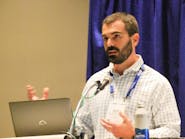In this era of global climate change, a growing number of regions seem to have too little and occasionally too much water. The latter is the case of late in the Permian Basin, where oil and gas operators will soon need to develop alternative methods of dealing with excess produced water, that is, water that emerges from the ground along with 50% of the nation’s crude oil and 20% of its natural gas.
Jeff Steinwinder, senior project engineer with Waggoner Engineering, explained this growing conundrum during his presentation, “Beneficial Reuse of Permian Basin Produced Water,” at this week’s WEFTEC conference in Chicago.
“What makes the Permian Basin an ‘unconventional’ oil field is that wells are drilled vertically to about 10,000 feet where the oil and gas are located, then the drilling goes horizontal,” he explained. Then, water is injected into the well at high pressures, “fracking” the surrounding shale deposits. “This water includes chemicals that help with the extraction of oil and gas. It also includes things like surfactants, biocides and scale inhibitors.” Also included are proppant, sandy grains that lodge in the fractures and allow for the continuous release of oil and gas over the well's 20- or 30-year lifespan.
“When we say oil and gas production in the permit, we always neglect to mention that there’s also ‘produced water’ that’s extracted out of these wells,” Steinwinder explained. And that produced water is invariably more than the amount of groundwater that’s been injected. “All told, two billion—that’s billion with a ‘b’—gallons of water are produced each day in the Permian Basin alone. And that number continues to grow as new wells go into production.”
Re-injection and recycling
The water that is extracted from the wells is routed to a central tank battery that provides a rough and primary treatment, or water separation. It also provides a zone for the recovery of oil and gas products. After the central tank battery, the water enters what is referred to as the water corridor—a network of pipes and pump stations that allow an operator to move the water where it needs to be.
“There are two main exits out of that water corridor,” Steinwinder continued. Some is re-injected underground into non-oil-bearing formations that are above or below the Wolfcamp Shale. Some is recycled for hydraulic fracturing, although only a fraction can be used due to quality issues. And as more and more wells come online, the output of produced water continues to grow. Further complicating matters, the longer a well is online, the more water (and fewer hydrocarbons) are produced. Another complicating factor is that reinjection of produced water above the Wolfcamp Shale has resulted in localized pressures as high as 500-psi in some areas, which in turn has led to seismic events.
Despite the continuous recycling and reinjection of produced water over time, “beginning in 2030, a small portion will have no place to go, and by 2034 expectations are that 300 million barrels per day will have no place to go,” said Steinwinder.
“So, why aren't we all deployed out the Permian right now working through some really cool, beneficial reuse treatment projects? Well, it's not yet economically feasible,” Steinwinder said. “Certainly, in the eyes of operators, it's still cheaper to inject the water into the subsurface through the permitted disposal wells at costs of about 60 cents per barrel, compared with beneficial reuse operations that will run $1.50 per barrel.”
Steinwinder went on to describe appropriate beneficial reuse treatments that may ultimately be brought to bear, including additional primary treatment to remove oils and grease solids, desalination and final polishing. “As technology advances, and as regulations become clearer, that pricing gap will narrow,” Steinwinder said.
“Lastly, I wanted to discuss emerging market opportunities in the permit,” Steinwinder concluded. “A place that has abundant water is ripe for beneficial reuse purposes of that water, and one that I'm sure we've all heard discussions about this week is the data center. Data center power requires a lot of water—and a number of data centers already have located into the Permian because of this opportunity.”
